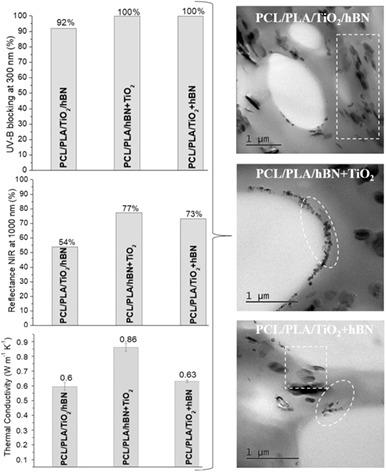当前位置:
X-MOL 学术
›
Polym. Eng. Sci.
›
论文详情
Our official English website, www.x-mol.net, welcomes your
feedback! (Note: you will need to create a separate account there.)
Multifunctional bionanocomposites with ultraviolet blocking, infrared reflection and thermal conductivity
Polymer Engineering and Science ( IF 3.2 ) Pub Date : 2020-08-12 , DOI: 10.1002/pen.25482 Marindia Decol 1 , Wagner M. Pachekoski 2 , Daniela Becker 1
Polymer Engineering and Science ( IF 3.2 ) Pub Date : 2020-08-12 , DOI: 10.1002/pen.25482 Marindia Decol 1 , Wagner M. Pachekoski 2 , Daniela Becker 1
Affiliation

|
The objective of this paper is investigating the effect of different localizations of titanium dioxide (TiO2) and hexagonal boron nitride (hBN) nanoparticles in the poly(lactic acid) (PLA)/poly(ε‐caprolactone) (PCL) blends on the ultraviolet (UV) blocking, infrared reflection (NIR), and thermal conductivity of the nanocomposites for the fabrication of bionanocomposites with high performance. Transmission electron microscopy images demonstrated that the different mixing sequences induced different nanoparticle localization in the immiscible PCL/PLA blend. These different localizations yielded differences in the properties of the hybrid quaternary nanocomposite. When the nanoparticles had different localizations, TiO2 at the interface and hBN in the PCL phase, the thermal conductivity was 0.86 Wm−1 K−1, 100% of UV radiation (λ = 300 nm) was blocked and 74% of NIR radiation was reflected. This nanocomposite has a strong potential for application as a multifunctional biodegradable film for agriculture, capable of absorbing UV radiation, reflecting NIR radiation, and conducting thermal energy.
中文翻译:

具有紫外线阻隔,红外反射和导热性的多功能生物纳米复合材料
本文的目的是研究聚乳酸(PLA)/聚ε-己内酯(PCL)共混物中二氧化钛(TiO 2)和六方氮化硼(hBN)纳米颗粒的不同局部化对硅橡胶的影响。纳米复合材料的紫外线(UV)阻挡,红外反射(NIR)和热导率可用于高性能制造生物纳米复合材料。透射电子显微镜图像表明,不同的混合顺序在不混溶的PCL / PLA共混物中诱导了不同的纳米粒子定位。这些不同的位置导致杂化季铵纳米复合材料的性能差异。当纳米粒子具有不同的局部化时,TiO 2在PCL相的界面和hBN处,热导率为0.86 Wm -1 K -1,阻挡了100%的UV辐射(λ = 300 nm),并反射了74%的NIR辐射。这种纳米复合材料具有强大的潜力,可以用作农业用多功能生物可降解薄膜,能够吸收紫外线,反射近红外辐射并传导热能。
更新日期:2020-10-17
中文翻译:

具有紫外线阻隔,红外反射和导热性的多功能生物纳米复合材料
本文的目的是研究聚乳酸(PLA)/聚ε-己内酯(PCL)共混物中二氧化钛(TiO 2)和六方氮化硼(hBN)纳米颗粒的不同局部化对硅橡胶的影响。纳米复合材料的紫外线(UV)阻挡,红外反射(NIR)和热导率可用于高性能制造生物纳米复合材料。透射电子显微镜图像表明,不同的混合顺序在不混溶的PCL / PLA共混物中诱导了不同的纳米粒子定位。这些不同的位置导致杂化季铵纳米复合材料的性能差异。当纳米粒子具有不同的局部化时,TiO 2在PCL相的界面和hBN处,热导率为0.86 Wm -1 K -1,阻挡了100%的UV辐射(λ = 300 nm),并反射了74%的NIR辐射。这种纳米复合材料具有强大的潜力,可以用作农业用多功能生物可降解薄膜,能够吸收紫外线,反射近红外辐射并传导热能。











































 京公网安备 11010802027423号
京公网安备 11010802027423号